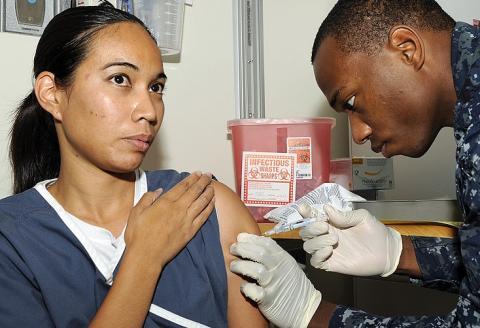Is flu vaccine “useless” this year?

USA are experiencing a peak in influenza activity, with the influenza A(H3N2) viruses being the most recurrent strain so far this season. A(H3N2) viruses are predominating also in Europe and in both cases they exhibit antigenic differences to the virus included in the 2014–2015 northern hemisphere influenza vaccine. The retirement of Fluad vaccines in some countries – and the bad communication about that – could have played a role in the decrease of vaccination rate.
“Useless” is the most common word used in headlines about flu vaccination last weeks, after the Centres for Diseases Control in Atlanta announced that they have recorded some mismatch between this year vaccine and one of the strains of viruses circulating in the beginning of the season. H3N2 flu virus, in fact, went through slight mutations in the past months, which could make the jab less effective towards this specific type of flu infection. This fact is complicated to explain, and so are its consequences.
But the trouble with the media is that they need headlines. And headlines need few words to convey a message that may be not so easy to synthetize. A title must catch readers’ attention, so that the practical implications of the news have to be underlined, even if they are only possible, not likely nor sure. In a title one cannot point on conditions, limits, and doubts about the news. One has to launch it. Readers, by their side, often stop at the title, especially in this era of lack of attention and of time. A correct health – and especially risk – communication is often impaired by this.
It is true that flu vaccination is not as effective as others are; in most years, for most populations, the shot provides protection for 60-70% of all vaccinated people against all the circulating strains combined. This percentage is lower for elderly, but since their risk of complications is higher in case of disease, health authorities recommend them to get immunized. We should not forget that the disease is widespread, hitting every year in the world 5%–10% of adults and 20%–30% of children, causing hospitalization and death mainly among high-risk groups (the very young, elderly or chronically ill). According to WHO, worldwide, these annual epidemics are estimated to result in about 3 to 5 million cases of severe illness, and about 250,000 to 500,000 deaths. In Europe, it kills about 40,000 people every year. Reducing this burden, even by a small percentage, can mean thousands of lives saved.
In February, every year, WHO experts meet and decide which are the main strains of flu virus to be expected to circulate the following year in the Northern hemisphere, based on what they saw in the winter of the Austral hemisphere. They do that so early because it takes about six months to produce a new vaccine against them. They could not foresee that H3N2 virus would have undergone a slight mutation in the following weeks. In the beginning of 2014-2015 flu season, CDC experts found that this mutant H3N2 virus, slightly different from the one used to prepare the vaccine, was prevailing, and launched an alarm, since a similar strain had shown to be quite severe in the past.
Did they mean that the vaccine is “useless”? Absolutely not. The virus mutation is not so deep to make the vaccine ineffective. It can offer some protection as well, since the virus remains a H3N2 one: even if one could get the disease, it would be milder, avoiding those complications that represents our main fears. In addition, the shot is effective against other circulating strains. On the contrary, it can a recommendation to get more people vaccinated, in order to achieve the same success. What CDC experts saw in USA, then, does not necessarily apply to Europe: prevailing strains are usually different in different areas of the world. Flu vaccine, then, is not “useless”. In Europe, as in the USA, it can still save thousands of lives.
